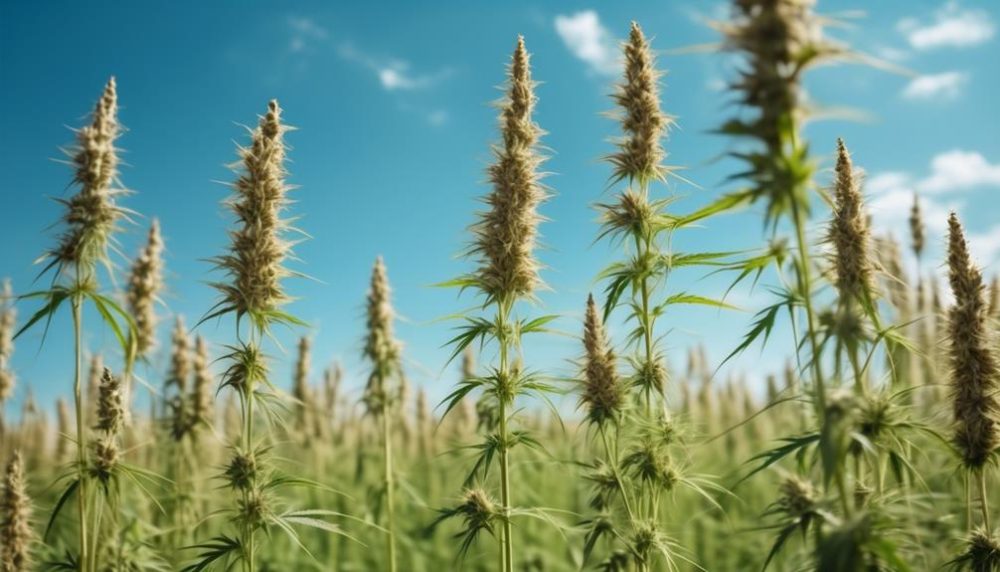
The EU Protein Strategy Report's endorsement of hemp as a sustainable protein source marks a significant development in the realm of food and feed diversification. With the European Parliament backing this recognition, it becomes evident that the EU is taking proactive steps to reduce reliance on external suppliers and strengthen its competitive position.
As we delve into the details, we will explore why hemp has emerged as a key player in the protein sector, its nutritional benefits, and how it compares to other sources.
Furthermore, we will uncover the additional uses of hemp beyond protein production, highlighting its potential in contributing to a more sustainable and resilient food chain.
Stay tuned to discover the significance of this endorsement and the implications it holds for the EU's protein strategy.
Key Takeaways
- The EU Protein Strategy Report recognizes hemp as a sustainable source of high-quality protein.
- The report emphasizes the importance of diversifying food and feed sources to reduce dependence on external suppliers.
- Hemp protein is nutritionally complete and comparable to animal protein in quality, making it a valuable addition to the food chain.
- Recognizing hemp as a protein source crop will lead to increased investment, research, and development in the sector, further boosting production and variety of hemp-based products.
Background of EU Protein Strategy Report
The Background of the EU Protein Strategy Report highlights the need for new food policies in response to extraordinary situations such as a pandemic and geopolitical tensions, emphasizing the importance of diversifying food and feed sources to reduce dependence on external suppliers.
Protein diversification plays a crucial role in ensuring food security. The report recognizes that protein is essential for both human and animal food and calls for measures to diversify sources to mitigate risks and vulnerabilities in the supply chain.
By diversifying protein sources, the EU aims to strengthen its food security and reduce its reliance on external suppliers, thus ensuring a stable supply of protein foods. This strategy is especially important in times of crisis when disruptions in the global food system can have severe implications for food security.
The report emphasizes the need for research, training, and a value chain approach to protein production to achieve these goals. By implementing these measures, the EU can enhance its competitive position and ensure a resilient and sustainable protein supply.
Hemp as a Sustainable Protein Source
Hemp is increasingly recognized as a sustainable protein source due to its rich nutritional profile and potential to address the need for diversification in the food and feed industry.
Hemp seeds have a remarkable nutritional composition, containing protein, essential fatty acids, fiber, iron, phosphorus, magnesium, and potassium. Hemp protein is considered one of the most complete plant proteins available, as it contains all the essential amino acids and is comparable in quality to animal protein. Additionally, hemp protein has high levels of arginine, which has been linked to cardiovascular health benefits.
Not only does hemp offer significant health benefits, but it also has a positive environmental impact. Hemp is a low-water and low-nutrient crop, making it sustainable and environmentally friendly. Furthermore, hemp cultivation has a negative carbon footprint, further supporting its reputation as one of the most ecological and sustainable foods available.
Nutritional Benefits of Hemp Protein
Renowned for its exceptional nutritional composition, hemp protein offers a range of essential amino acids and bioactive compounds that contribute to a well-rounded and highly beneficial dietary supplement. Here are some of the key nutritional benefits of hemp protein:
- Complete protein: Hemp protein is one of the most complete plant proteins available, containing all the essential amino acids. It is comparable to animal protein in terms of quality and can be an excellent option for those following a plant-based diet.
- High arginine content: Hemp protein has a high content of arginine, an amino acid that plays a crucial role in cardiovascular health. It also contains bioactive peptides that have been linked to various heart health benefits.
- Superior amino acid profile: Hemp protein surpasses soy or pea protein in terms of sulfur-containing amino acids, which are important for building and repairing tissues in the body.
- Digestibility and assimilation: Hemp protein is easily digested and assimilated in the body, making it a highly bioavailable source of protein.
In addition to its health benefits, hemp protein also has a positive environmental impact. Hemp is a sustainable crop that requires less water and nutrients compared to other plants. It has a negative carbon footprint and can be used in phytoremediation to remove contaminants from the soil. By incorporating hemp protein into our diets, we can support both our health and the environment.
Comparing Hemp Protein to Other Sources
With its exceptional nutritional composition and environmental benefits, hemp protein stands out among other protein sources, making it a viable option for individuals seeking a sustainable and high-quality plant-based protein.
When comparing hemp protein to animal protein, hemp protein offers several advantages. Firstly, hemp protein is derived from plant sources, making it suitable for vegetarians and vegans. Secondly, hemp protein is free from cholesterol and saturated fats, which are commonly found in animal protein sources. Additionally, hemp protein contains all the essential amino acids, making it a complete protein, comparable to animal protein in terms of quality.
Furthermore, hemp protein is easily digestible and assimilated by the body. When compared to other plant protein sources, such as soy or pea protein, hemp protein has a higher content of arginine, an amino acid with cardiovascular health benefits. Moreover, hemp protein is superior to soy or pea protein in terms of sulfur-containing amino acids.
Additional Uses of Hemp
One notable aspect of hemp is its versatility, as it can be used in various industries for different purposes. Some of the additional uses of hemp include:
- Hemp for sustainable textiles: Hemp fibers have long been used in the manufacturing of clothing, paper, ropes, and bioconstruction materials. The fibers are known for their strength and durability, making them an excellent alternative to traditional textiles.
- Hemp in phytoremediation: Hemp has the unique ability to remove contaminants from the soil through a process called phytoremediation. It can absorb toxins such as heavy metals, pesticides, and radioactive elements, making it a valuable tool for cleaning up polluted environments.
- Hemp as a raw material for bioplastics and bioenergy: Hemp stalks can be used as a renewable and sustainable source of raw material for the production of bioplastics and bioenergy. This reduces reliance on fossil fuels and contributes to a more environmentally friendly approach.
- Hemp as a low-water and low-nutrient crop: Hemp requires minimal water and nutrients to grow, making it a sustainable crop choice. Its cultivation does not place a significant burden on water resources or contribute to soil degradation.
Significance of Hemp Recognition in the EU
The recognition of hemp as a protein source crop in the EU underscores its significance in the food chain and paves the way for increased investment, research, and development in the sector. This recognition opens up new investment opportunities and capitalizes on the growing market demand for sustainable protein sources.
With the endorsement of hemp as a sustainable source of high-quality protein, there is an increased focus on the production and variety of hemp-based products. This not only benefits the hemp industry but also contributes to the diversification of food and feed sources, reducing dependence on external suppliers.
The European Hemp Industry Association has played a significant role in the recognition of hemp, helping to normalize its use and consolidate its position in nutrition and sustainability. The recognition of hemp in the EU Protein Strategy Report has set the stage for a promising future in the hemp protein sector.
Relevance of EU Protein Strategy Report
The EU Protein Strategy Report is a crucial document that addresses vulnerabilities in the supply chain and outlines the necessary measures to ensure a stable supply of protein foods and strengthen the EU's competitive position. This report recognizes the importance of diversifying food and feed sources to reduce dependence on external suppliers, and it specifically acknowledges hemp as a sustainable source of high-quality protein.
The relevance of the EU Protein Strategy Report lies in its emphasis on the role of hemp in food security and sustainable agriculture. By recognizing hemp as a valuable protein source, the report promotes investment in the sector, research, and development, leading to increased production and variety of hemp-based products.
This recognition also helps normalize the use of hemp and solidify its position in nutrition and sustainability efforts.
- Importance of hemp in food security
- Role of hemp in sustainable agriculture
- Promotion of investment and research in the hemp sector
- Consolidation of hemp's position in nutrition and sustainability
Frequently Asked Questions
What Are Some Examples of External Suppliers That the EU Is Looking to Reduce Dependence on in Terms of Protein Sources?
Examples of external suppliers that the EU aims to reduce dependence on in terms of protein sources include imports of soybeans and other feed materials. Diversification of protein sources, such as hemp, is crucial to enhance food security and reduce reliance on external markets.
How Does Hemp Protein Compare in Terms of Sulfur-Containing Amino Acids to Soy or Pea Protein?
In terms of sulfur-containing amino acids, hemp protein is superior to soy or pea protein. It offers a higher content of these essential amino acids, making it a valuable plant-based protein source for individuals seeking a balanced nutritional profile.
Can You Provide More Information on the Bioactive Peptides Found in Hemp Protein and Their Specific Cardiovascular Health Benefits?
Bioactive peptides found in hemp protein have been shown to have specific cardiovascular health benefits. Hemp protein, compared to soy or pea protein, has a superior content of sulfur-containing amino acids, making it a favorable choice for individuals seeking cardiovascular support.
What Are Some Examples of Hemp-Based Products That Could See Increased Production and Variety as a Result of the Recognition of Hemp as a Protein Source Crop?
Increased recognition of hemp as a protein source will likely lead to increased demand for hemp-based protein powders, as well as the development of new hemp-based protein bars and snacks to cater to the growing market.
How Does the Recognition of Hemp as a Sustainable Protein Source Contribute to the Normalization of Its Use and Consolidation of Its Position in Nutrition and Sustainability?
The recognition of hemp as a sustainable protein source contributes to the normalization of its use and the consolidation of its position in nutrition and sustainability. It increases awareness, investment, and research, leading to a wider range of hemp-based products and a more mainstream acceptance of hemp's benefits.
Conclusion
In conclusion, the endorsement of hemp as a sustainable protein source in the EU Protein Strategy Report holds significant implications for the food and agricultural sectors.
With its rich nutritional profile and various applications beyond protein production, hemp offers a promising solution to diversifying food and feed sources.
This recognition not only strengthens the EU's competitive position but also fosters investment, research, and development in the sector.
By embracing hemp, the EU reinforces its commitment to sustainability and ensures a stable supply of protein foods.
